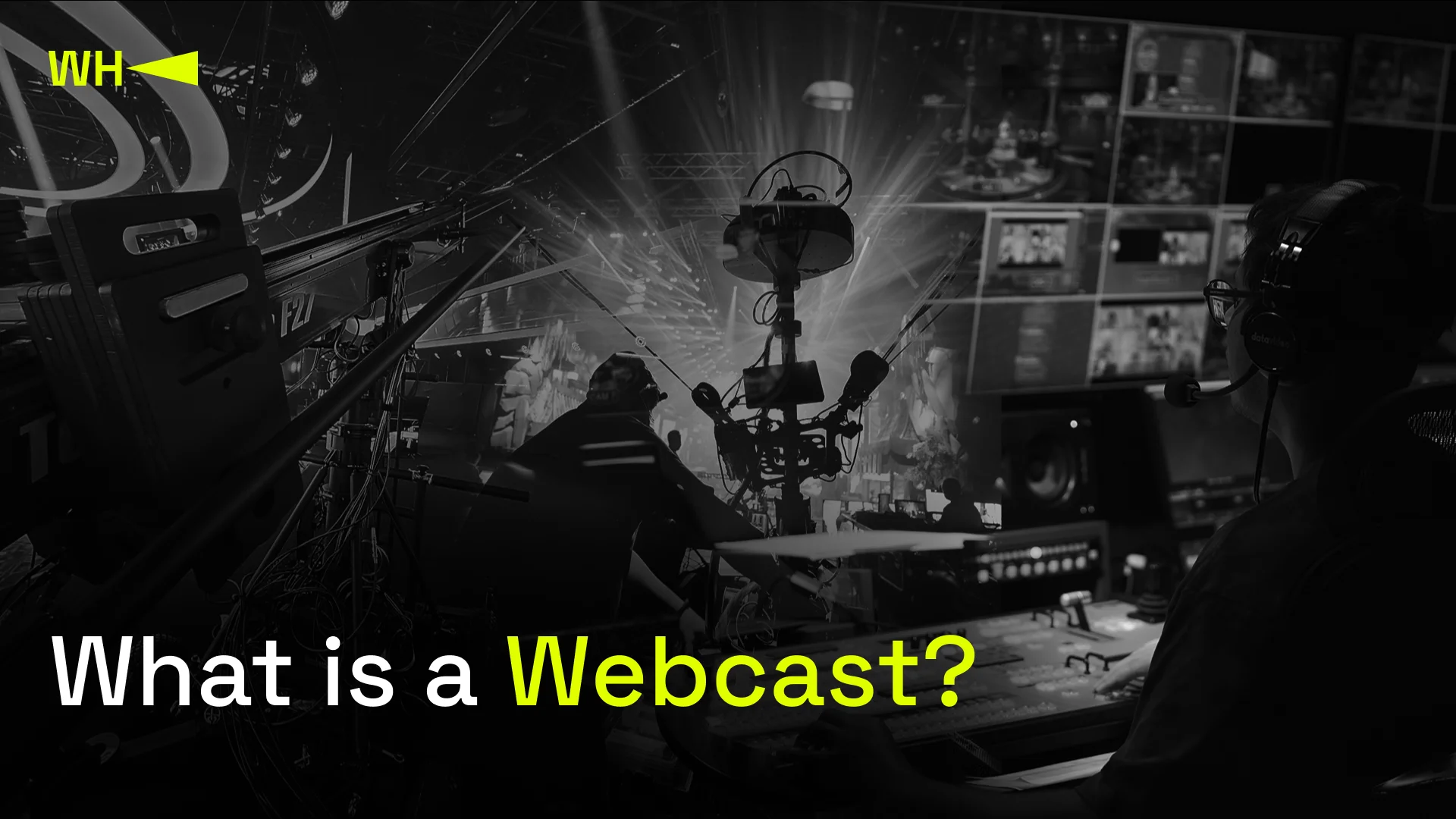Jan. 12, 2024
What is a Webcast?

5 min read
The term webcast, although not new, can still cause confusion as to its meaning. In fact, any broadcast on the internet can be labeled a webcast — that is, the type of content is not so important as the way in which it is delivered to a wide audience.
Typically, as a broadcast, a webcast uses one-to-many communications, meaning that one source distributes content to many recipients, but sometimes, you come across formats that use many-to-many interaction.
Webcasts appeared back in the ’90s. One of the most popular cases is the project of Jenny Ringley, who installed a web camera photographing her every few minutes and broadcasting those images live on the JenniCam website. Сamera quality and webcasting technology have improved significantly since then, and now people can enjoy live content that is distributed to every corner of the planet without a hitch. The digital era has given rise to various online content formats, including webcasts, podcasts, webinars, livestreams, and more, all accessible to anyone with an internet connection. So what is a webcast?
Is webcast a live video stream?
Technically, no, but both terms are used interchangeably. Both webcasting and livestreaming imply broadcasting content over the internet in real time. However, a webcast can also use pre-recorded media elements, while a live stream involves continuous live transmitting only.
Plus, livestreaming often means any live broadcast — there is no difference between a livestream on YouTube and an online broadcast of a football match. A webcast means a more prepared event that includes speakers, webcast software, different types of content, and a specific topic.
Nevertheless, there is no big difference between the terms since a webcast can be a livestream, and a livestream can be a webcast.
On-demand webcast vs live webcast
There are live webcasts and on-demand ones. The difference between them is obvious. The former follow a schedule and are fully based on an online component, attracting participants in real time. Recorded webcasts provide the convenience of on-demand viewing across different time zones for diverse audiences.
Naturally, recorded broadcasts are available to more people, but statistics show that engagement on online broadcasts is much higher. On average, on-demand viewers watch only half of the event. During a live broadcast, it is easier to establish two-way communication, launch interactive campaigns, and so on.
Benefits of webcasting and virtual events for your brand
The benefits of a webcast are almost the same as those of a livestream. However, a lot depends on production quality. For example, interactivity, high engagement rates, and the number of views do not depend on whether it’s a live event or not but only on what content and format you offer.
- Large audiences
Getting an event online helps transcend physical boundaries and deliver content worldwide. Webcasts are the most accessible way for companies to expand their influence beyond the local market and attract a global audience for panel discussions or any other type of event.
- Cost-effective solution
Venue rental, travel expenses, and equipment transfer are must-have expenses when it comes to hosting a physical event. Funding the webcast cost is a more convenient way to allocate budget and resources, saving money on in-person event-related expenses.
- On-demand viewing
However convenient the time you choose for your event, still, not everyone will be able to attend. Webcasting can solve this problem due to its flexibility. By saving your livestream for later viewing, you ensure your viewers don’t miss anything and can come back to watch the content when they have some time to spare.
What can be made into a webcast?
Webcasts serve different purposes and are used in different industries. Corporations use them for internal affairs, brands for marketing moves, and content creators for, well, actually creating content. Let’s look at some examples.
A training session for corporate communications
Many company processes depend on each employee being familiar with all aspects of the workflow. The larger the company, the more difficult it is to transfer information from person to person and handle internal communication. So, instead of gathering employees and all participants in company event halls, you can use webcasts for training sessions to reach large audiences and provide effective communication. International companies can use a tool that allows them to store and enable a limitless content delivery network.
A product launch presentation for marketing purposes
Webcasts are also widely used for marketing purposes, for example, in presentations of new products. When showcasing their new solutions, Apple uses webcasts to feature different speakers. In this way, the brand shows the benefits of its products by mixing various types of content: videos, infographics, photos, and so on. Thanks to live webcasting, the company’s product launches didn’t stop even during COVID-19 and sanitary restrictions.
A virtual event in the entertainment industry
For the show business, webcasts have become one of the main tools for promoting content online. Content creators organize live streams of online concerts and virtual events. Music concerts, entertainment shows, award ceremonies, and much more have become available to tens of thousands of followers around the world thanks to webcasts. For example, WePlay Studios organizes virtual events, often streamed in real time, which garner hundreds of thousands of views. It is hard to imagine a physical event that can gather so many spectators in one place, while livestreaming makes events accessible to an unlimited number of attendees with an internet connection.
The first webcasts were not at all like the modern ones. Nowadays, a webcast works fast and steady, becoming an indispensable tool in many domains and, if used correctly, can have many benefits both for the company’s internal processes and for external ones. The ability to combine elements of live content and pre-recorded videos, distribute the material freely, and recruit speakers from all over the world makes the webcast production process much more comprehensive compared to the events of yesteryear. So, in almost every industry, this tool has something to contribute.
